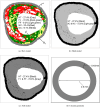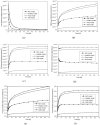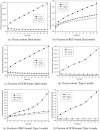Plaque heterogeneity and the spatial distributions of its components dictate drug-coated balloon therapy
- PMID: 38388639
- PMCID: PMC11053051
- DOI: 10.1038/s41598-024-54756-9
Plaque heterogeneity and the spatial distributions of its components dictate drug-coated balloon therapy
Abstract
Drug-coated balloon (DCB) angioplasty is one of the potential approaches to alleviating in-stent restenosis and treating peripheral artery disease. An in-silico model has been developed for sirolimus drug eluted from an inflated balloon in a patient-specific arterial cross-section consisting of fibrous tissue, fibrofatty tissue, dense calcium, necrotic core, and healthy tissue. The convection-diffusion-reaction equation represents the transport of drug, while drug binding, both specific and non-specific, can be modelled as a reaction process. The Brinkman equations describe the interstitial flow in porous tissue. An image processing technique is leveraged for reconstructing the computational domain. The Marker and Cell, and Immersed Boundary Methods are used to solve the set of governing equations. The no-flux interface condition and convection do amplify the tissue content, and the regions of dense calcium and necrotic core limited to or extremely close to the interface pose a clinical threat to DCB therapy. Simulations predict the effects of the positioning and clustering of plaque components in the domain. This study demands extensive intravascular ultrasound-derived virtual histology (VH-IVUS) imaging to understand the plaque morphology and determine the relative positions of different plaque compositions about the lumen-tissue interface, which have a significant impact on arterial pharmacokinetics.
Keywords: Drug-coated balloon; MAC and IBM method; Plaque heterogeneity; Spatial distributions; Tissue content.
© 2024. The Author(s).
Conflict of interest statement
The authors declare no competing interests.
Figures











Similar articles
-
Effect of Interstitial Fluid Flow on Drug-Coated Balloon Delivery in a Patient-Specific Arterial Vessel with Heterogeneous Tissue Composition: A Simulation Study.Cardiovasc Eng Technol. 2018 Jun;9(2):251-267. doi: 10.1007/s13239-018-0345-2. Epub 2018 Mar 5. Cardiovasc Eng Technol. 2018. PMID: 29508375
-
Reproducibility of Shin's method for necrotic core and calcium content in atherosclerotic coronary lesions treated with bioresorbable everolimus-eluting vascular scaffolds using volumetric intravascular ultrasound radiofrequency-based analysis.Int J Cardiovasc Imaging. 2012 Jan;28(1):43-9. doi: 10.1007/s10554-010-9779-9. Epub 2011 Jan 13. Int J Cardiovasc Imaging. 2012. PMID: 21229393
-
Atherosclerotic plaque composition assessed by virtual histology intravascular ultrasound and cerebral embolization after carotid stenting.J Vasc Surg. 2010 Nov;52(5):1188-94. doi: 10.1016/j.jvs.2010.05.101. Epub 2010 Jul 23. J Vasc Surg. 2010. PMID: 20655687
-
[New methods of coronary imaging II. Intracoronary ultrasonography in clinical practice].Ital Heart J Suppl. 2001 Jun;2(6):579-92. Ital Heart J Suppl. 2001. PMID: 11460831 Review. Italian.
-
How clinically effective is intravascular ultrasound in interventional cardiology? Present and future perspectives.Expert Rev Med Devices. 2013 Nov;10(6):735-49. doi: 10.1586/17434440.2013.841353. Expert Rev Med Devices. 2013. PMID: 24195458 Review.
Cited by
-
Modelling Hollow Microneedle-Mediated Drug Delivery in Skin Considering Drug Binding.Pharmaceutics. 2025 Jan 14;17(1):105. doi: 10.3390/pharmaceutics17010105. Pharmaceutics. 2025. PMID: 39861753 Free PMC article.
-
Drug-Coated Balloons: Recent Evidence and Upcoming Novelties.J Cardiovasc Dev Dis. 2025 May 20;12(5):194. doi: 10.3390/jcdd12050194. J Cardiovasc Dev Dis. 2025. PMID: 40422965 Free PMC article. Review.
-
Drug coated balloons in percutaneous coronary intervention: how can computational modelling help inform evolving clinical practice?Front Med Technol. 2025 Apr 30;7:1546417. doi: 10.3389/fmedt.2025.1546417. eCollection 2025. Front Med Technol. 2025. PMID: 40370491 Free PMC article. Review.
References
-
- Levine GN, et al. 2011 accf/aha/scai guideline for percutaneous coronary intervention: A report of the American College of Cardiology Foundation/American Heart Association task force on practice guidelines and the society for cardiovascular angiography and interventions. J. Am. Coll. Cardiol. 2011;58:e44–e122. doi: 10.1016/j.jacc.2011.08.007. - DOI - PubMed
MeSH terms
Substances
LinkOut - more resources
Full Text Sources
Medical

